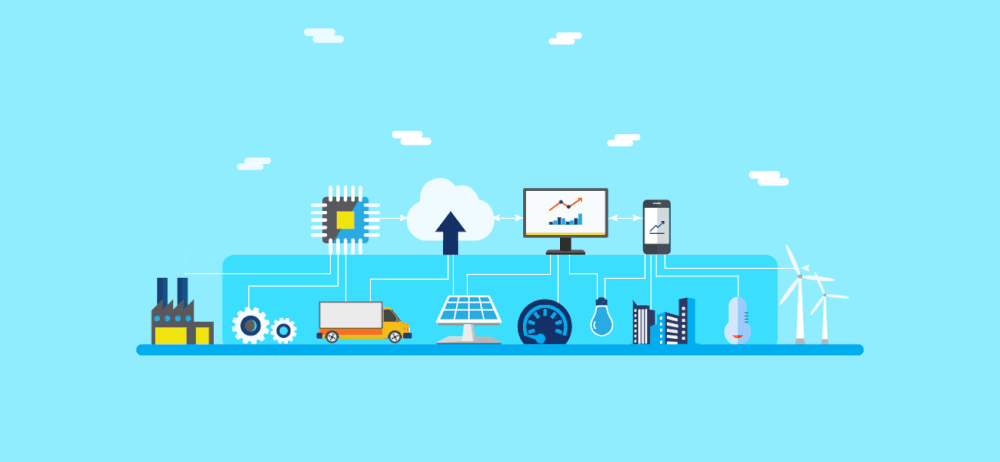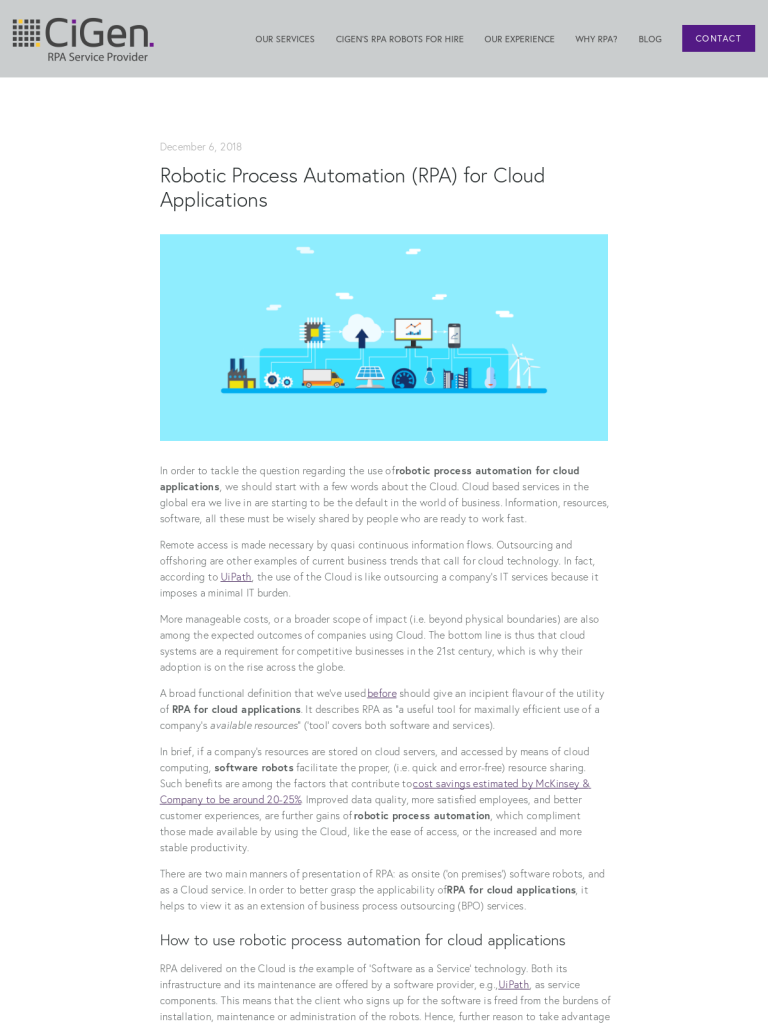Robotic Process Automation (RPA) for Cloud Applications
Original post from https://www.cigen.com.au/cigenblog/

In order to tackle the question regarding the use of robotic process automation for cloud applications, we should start with a few words about the Cloud. Cloud based services in the global era we live in are starting to be the default in the world of business. Information, resources, software, all these must be wisely shared by people who are ready to work fast.
Remote access is made necessary by quasi continuous information flows. Outsourcing and offshoring are other examples of current business trends that call for cloud technology. In fact, according to UiPath, the use of the Cloud is like outsourcing a company’s IT services because it imposes a minimal IT burden.
More manageable costs, or a broader scope of impact (i.e. beyond physical boundaries) are also among the expected outcomes of companies using Cloud. The bottom line is thus that cloud systems are a requirement for competitive businesses in the 21st century, which is why their adoption is on the rise across the globe.
A broad functional definition that we’ve used before should give an incipient flavour of the utility of RPA for cloud applications. It describes RPA as “a useful tool for maximally efficient use of a company’s available resources” (‘tool’ covers both software and services).
In brief, if a company’s resources are stored on cloud servers, and accessed by means of cloud computing, software robots facilitate the proper, (i.e. quick and error-free) resource sharing. Such benefits are among the factors that contribute to cost savings estimated by McKinsey & Company to be around 20-25%. Improved data quality, more satisfied employees, and better customer experiences, are further gains of robotic process automation, which compliment those made available by using the Cloud, like the ease of access, or the increased and more stable productivity.
There are two main manners of presentation of RPA: as onsite (‘on premises’) software robots, and as a Cloud service. In order to better grasp the applicability of RPA for cloud applications, it helps to view it as an extension of business process outsourcing (BPO) services.
How to use robotic process automation for cloud applications
RPA delivered on the Cloud is the example of ‘Software as a Service’ technology. Both its infrastructure and its maintenance are offered by a software provider, e.g., UiPath, as service components. This means that the client who signs up for the software is freed from the burdens of installation, maintenance or administration of the robots. Hence, further reason to take advantage of software robots delivered on the Cloud.
A relevant feature of cloud applications is their pervasiveness
The Cloud works as an “all around” software system, spanning across a large plethora of business processes, everything from accounting to production. Previously we explained why not choosing the right processes to automate in the beginning is a significant pitfall of robotic process automation.
We also recommended some questions which can facilitate a good process choice. The wide span of cloud technology seems to be a good match with the rather complex decision making involved in selecting the right processes to be automated. This is so because whichever process is chosen as pilot for the automation journey, the likelihood that it be covered by the Cloud is high.
Cloud technology easens and fastens digitisation in the form of robotic process automation
RPA for cloud applications can grow faster than on-premise implementations because the Cloud sets aside the need for prior testing: the software robot can be directly used for doing whatever it’s been programmed to do.
This has a number of positive consequences. On the one hand, robotic process automation for cloud applications provides an opportunity to make use of the great potential of robotics without in-depth knowledge about robotics. This allows business experts in your company to get more involved in the automation procedure, and thereby avoid potential divergences with the IT departments (which are not at all uncommon). Not having to rely on considerable IT support also contributes to maintaining project costs in a reasonable range.
Robotic process automation (RPA) is easily implemented in the Cloud
The ease of RPA implementation on Cloud systems makes the Cloud a springboard for a crucial feature of software robots, namely, scalability. In fact, scalability and replicability (in virtue of the communication and sharing facilities offered by the Cloud) are the main benefits of RPA for cloud applications.
One important problem when it comes to using the Cloud concerns the companies which are more attached to their legacy systems; its implementation is more difficult in such cases. RPA can assist in sidestepping the issue.
Its dual delivery, on Cloud and on-premise, has a big potential to bridge the gap between the old (the legacy systems) and the new (the Cloud). Businesses need to integrate Cloud and on-premise systems in order to keep up with the world of business moving forward, yet maintain their ‘uniquely defining widgets’.
Thank you. We will be in touch shortly.
When do you need software robots for Cloud applications?
One example is when you must provide continuous, 24/7 back-up for data transfer from the Cloud to the on premise system of record, in order to stay safe from the potential failure of the source system (i.e., the Cloud). If you were to rely on human labour for this task, you would have to hire several employees to manually do the transfer, which would significantly up the project costs.
On the other hand, the repetitive, quasi exception-free nature of the task makes it perfectly suitable to be carried out by bots – faster, without error, and without extreme fatigue and corresponding dissatisfaction. Hence, the use of bots with their head in the Cloud is likely to result in a considerable competitive advantage for your business.
Another noteworthy upshot of the use of robotic process automation for cloud applications might be a good reputation for your company, of openness to ‘navigate’ through the latest technological developments.
Conclusion
We can already envision the reality of a future that, not long ago, might have seemed rather SciFi. With respect to business, this future seems to have two defining characteristics: business operations undergoing digital transformation, and business platforms being cloud-based. It’s easy to see that RPA for cloud applications is by definition an integration of the two, which has a tremendous potential to keep you company moving forward.
Moreover, the use of robotic process automation delivered as a Cloud service is not at all in the clouds, rather it looks like a practice as close as possible to the immediate reality. Randall Hodges, business operations leader specialising in Intelligent Automation, brilliantly expresses this idea by saying that “Robotic Process Automation currently seems like our best bet to bridge the distance from Earth to the ‘Clouds’.“
Leave a Comment
You must be logged in to post a comment.








